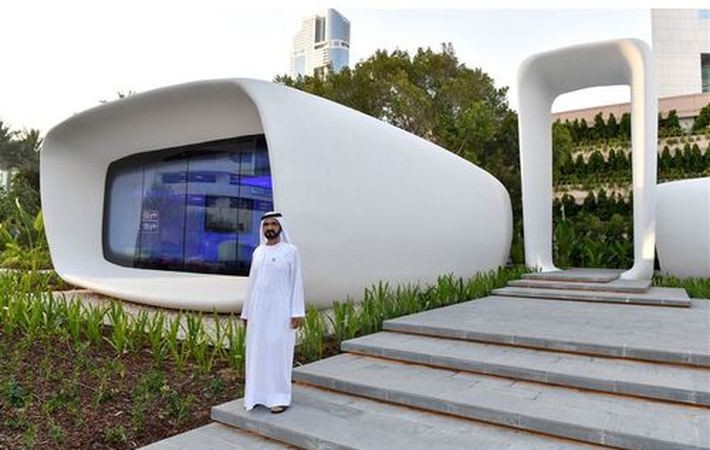
Published on 11/17/2016 | Market Sizing
Welcome to the future of construction. In May, the Dubai government announced successful completion of the world’s first 3D-printed office building. Everything about the building – and everything inside – is entirely made from a 3D printer, right down to the interior furniture. Compete with phone hookups, air conditioning, and utilities, the building fittingly serves as the temporary home of the Dubai Future Foundation. It took only 17 days to print the entire building on a giant, 120 feet long and 40 feet wide, 3D printer, and only two days to install it. The price tag is anything but big. According to United Arab Emirates minister of cabinet affairs Mohamed Al Gergawi, the building cost only $140,000, roughly half the price of traditional construction.
From apartments to office buildings, 3D printing is disrupting the construction industry by redefining both the design and production process. Compared with traditional forging, sculpting, and molding, the 3D printing process is a fraction of the time and cost. It is one of the key innovations disrupting the construction industry and rapidly transforming it from a manual, low-productivity industry into an automated, high-productivity industry.
Also known as additive manufacturing, 3D printing transforms a three-dimensional digital model into a physical object by adding material layer by layer. Today, 3D printers are capable of printing an entire home in 20 hours. While the printer used in Dubai to construct the office building was quite large in scale, much smaller 3D printers are also available, enabling small businesses and consumers to print at home and onsite.
Chinese company WinSun Decoration Design Engineering is at the forefront of the 3D printing revolution. In 2014, the company constructed 10 houses in under 24 hours. In 2015, it followed up by constructing the world’s tallest 3D printed building. While the five-story apartment block was just for display purposes, the construction company says it is fully habitable. According to the chief engineer of China Construction No.8 Engineering Bureau, Ma Rongqua, the building is in “full compliance with the relevant national standards.” Rongqua, who characterized the building as safe and reliable with “a good integration of architecture and decoration,” also cautioned that there is no specific national standard for 3D printing architecture.
The benefits of 3D printing go beyond simply constructing prefabricated building pieces. Companies are also testing the use of robotics to pour concrete from 3D designs. Doing so allows contractors to achieve greater precision, uses 30% to 60% less building materials, and speeds the delivery process by 50% to 80%. Mockup miniaturization using building information modeling (BIM) and 3D printing will eliminate the need for full-scale mockups. Laser scanners will confirm field dimensions to within 1/100 of an inch and communicate with suppliers, ensuring prefabricated components connect without fail.
Portakabin is a UK-based construction company that builds portable and modular buildings with the use of 3D technology. A leading modular building innovator for more than 50 years, Portakabin currently operates in six countries and employs more than 1,300 people. Portakabin recently developed the Yorkon Building System, which features over 2,500 precision components that deliver construction-level accuracy down to a fraction of a millimeter. According to Portakabin, the Yorkon Building System provides businesses with benefits that go beyond a traditional build, including “the ability to fit any footprint and external walls without sections or columns.” An added bonus: the system allows the finished product to be complete 50% faster than traditional buildings. This construction flexibility also allows architects to give clients exactly what they want in terms of design without compromising structural integrity.
In the Netherlands, DUS Architects 3D printed the “Canal House,” which links science, design, construction, and community at an open building site in the heart of Amsterdam. Printed in 2014, Canal House is the world’s first 3D-printed house that uses a printer made from a shipping container (roughly 10 times the size of typical 3D printers), further reflecting the role of innovation and disruption within the construction industry.
Truly, 3D printing is a game changer that demands an entirely new digital framework to map construction processes for fundamentally higher performance. This includes new digital solutions that link workforce engagement with supplier networks (including sensors, 3D printing, and robotics) together with project applications. These applications include: estimating cost control; enhanced resource, issue, and change management; real-time forecasting; risk management; scheduling; and work planning.
The journey to define future business models capitalizing on the digital construction economy involves all aspects of a modern contractor and requires a systematic approach to identify and capture business opportunities. Clearly, 3D printing is one of these business opportunities, and it is poised to profoundly disrupt the construction industry.
You can find the original article here.